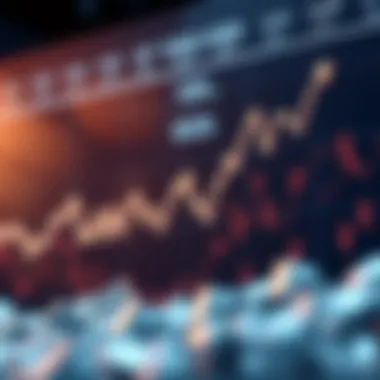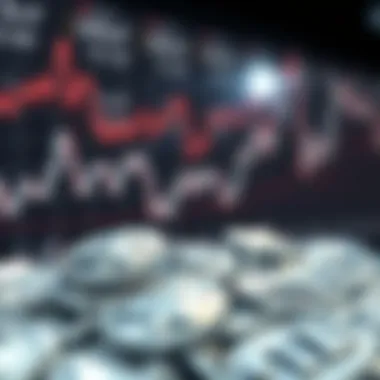Understanding XAG/USD: A Deep Dive into Silver's Value


Intro
The world of currency trading can sometimes feel like a wild tango, with ever-shifting steps that demand keen insight and agility. Among the intricate pairs in this arena, XAG/USD stands out due to the complexities surrounding silver's valuation against the U.S. dollar. Understanding these dynamics is vital for investors, traders, and tech professionals alike, as the movements in this market can present both significant opportunities and challenges.
In this article, we will embark on a detailed journey to dissect the various factors that influence XAG/USD. From the economic indicators that sway investor sentiment to the historical performance of silver, our goal is to arm you with a wealth of information. With an eye on the past, we’ll also explore forward-looking strategies that can help navigate this fascinating market.
Understanding Cryptocurrency Market Trends
Currency markets fluctuate based on a multitude of elements, and silver's position in this ecosystem can be particularly telling. As we delve into current market analysis and historical performance, we aim to pin down the subtleties that shape the value of silver.
Current Market Analysis
At present, the trading environment for XAG/USD reflects broader economic trends. For instance, inflationary pressures in the U.S. can lead to increased demand for silver, which many investors turn to as a hedge. Similarly, geopolitical tensions often send shockwaves through the market, prompting shifts in trading behavior.
A close observation of analysts' reports indicates that investor interest tends to surge in times of uncertainty. Just like a moth drawn to a flame, traders flock to assets perceived as safe havens, with silver frequently featured in this regard. This dynamic is crucial for comprehending the factors at play in XAG/USD.
Historical Performance and Lessons Learned
When examining the past, several key lessons emerge from silver's historical performance. For example, the 2008 financial crisis acted as a significant turning point, showcasing silver's ability to hold its ground amid economic turmoil. During that period, prices climbed as investors sought refuge in precious metals.
This resilience has forged a narrative around silver that plays into its valuation against the dollar. The market oscillates, and historical price trends suggest that understanding past behavior can equip current traders to make informed decisions.
"Historical patterns in the XAG/USD pair reveal a cyclical nature that traders can leverage, particularly during times of economic fluctuation."
Practical Guides for Crypto Investors
With a clear grasp of the trends, it becomes paramount to explore actionable strategies for those looking to engage with the XAG/USD pair. Comprehensive trading strategies and robust risk management techniques serve as foundational elements for success.
Step-by-Step Trading Strategies
- Technical Analysis: Familiarize yourself with chart patterns, moving averages, and indicators to gauge market momentum. This step serves as your compass amidst the volatile seas of currency trading.
- Fundamental Analysis: Keep an eye on economic indicators, such as U.S. employment data and manufacturing reports, that can impact the dollar's strength and in turn, silver's value.
- Setting Entry and Exit Points: Establish well-defined entry and exit thresholds based on your analysis, thereby placing you in a better position for profitable trades.
Risk Management Techniques
Investing is often akin to walking a tightrope; a balance between risk and reward is essential. An effective strategy includes:
- Position Sizing: Determine how much capital to risk on each trade, ensuring it aligns with your overall strategy.
- Diversification: Don't put all your eggs in one basket. Spread your investments across various assets to mitigate risk.
- Regular Review: Analyze your trading outcomes periodically, reflecting on both successful and unsuccessful trades to enhance your future strategies.
Culmination
Understanding the dynamics of XAG/USD offers traders a window into the complex world of silver trading against the backdrop of the U.S. dollar. This comprehensive analysis, encompassing market trends, historical insights, and practical trading strategies lays the groundwork for informed engagement in the silver market.
For further reading and in-depth analysis, check valuable resources like Investopedia and economic reports on U.S. Department of Labor. Engaging actively with these tools, investors can make well-informed decisions that reflect not only current trends but also historical patterns that echo through market cycles.
Prelims to XAG/USD
The landscape of global finance is increasingly dynamic, and understanding how currencies interact can provide traders and investors with a powerful edge. This section sets the stage for a deeper exploration of XAG/USD, a trading pair that showcases the value of silver against the U.S. dollar. Understanding XAG/USD is pivotal as it reflects not only the market's sentiment towards silver but also broader economic conditions.
Definition of XAG/USD
XAG/USD represents the exchange rate of silver measured in U.S. dollars. In simple terms, it tells you how much one ounce of silver costs in dollars. The designation "XAG" denotes silver in the international currency code system, while the "USD" stands for the United States dollar. This relationship is significant for anyone involved in commodity trading, particularly those focusing on precious metals.
To put it plainly, if the XAG/USD exchange rate is 25.00, it means one ounce of silver is valued at 25 U.S. dollars. Traders use this pair to speculate on price movements or hedge against economic uncertainties, making it vital to grasp its implications.
Historical Context
A rich historical backdrop significantly informs the current trading dynamics of XAG/USD. Silver has held value for millennia, serving various roles from currency to an industrial metal. Historically, it has garnered attention as a safe haven, particularly during times of economic instability. This history intertwines with the evolving status of the U.S. dollar, which emerged as a dominant global reserve currency in the 20th century.


- Early Uses of Silver: In ancient civilizations, silver was not just a commodity; it was often used in trade and as currency. Its intrinsic value fostered trust among nations.
- The Gold Standard: In the 19th century, many economies, including that of the U.S., pegged their currencies to gold, indirectly affecting silver's status. Silver was also included in some systems, sustaining its relevance in foreign trade.
- Modern Developments: In recent decades, market fluctuations have often made silver more volatile compared to gold. Factors such as industrial demand and central bank policies also play a crucial role in determining the XAG/USD exchange rate.
Understanding these historical underpinnings can greatly enhance an investor's perspective when navigating the complexities of the silver market today.
By recognizing the roots of silver's value, traders can make more informed decisions based on historical trends and current market conditions.
The Composition of XAG/USD
Understanding the composition of XAG/USD is essential because it offers insights into the intricate relationship between silver and the U.S. dollar. These two elements interact under various market conditions, making it necessary for traders and investors to grasp how each influences the other in the global financial landscape. The XAG/USD pairing matters not just for its trading potential, but also for what it reveals about economic stability, inflation rates, and currency strength. Recognizing this interplay can lead to more strategic trading decisions, affording participants a clearer view of the market.
Understanding Silver as a Commodity
Silver has been recognized as a valuable commodity for centuries. Its intrinsic value comes not only from its use in currency but also its applications in technology and industry. For instance, silver plays a crucial role in electronics; its conductivity makes it irreplaceable in many high-tech devices. The demand for silver tends to rise in sectors like solar energy and medical technology, where it is often used for its properties. As such, fluctuations in industrial demand can strongly influence XAG/USD rates.
Investors often seek silver as a hedge against inflation and currency devaluation. In times where the dollar weakens, savvy traders might flock to silver, driving up its price. This counters a decrease in the dollar's value. Additionally, due to its dual role as both an industrial commodity and a financial asset, understanding the economic indicators that affect demand for silver is imperative. Supply dynamics also play a critical role. Factors like mining production levels and geopolitical tensions in major silver-producing countries (e.g., Mexico and Peru) can significantly sway prices. Thus, keeping an eye on both supply and demand trends is vital for anyone involved in trading XAG/USD.
Role of the U.S. Dollar
The U.S. dollar operates as the global reserve currency, which means its strength or weakness profoundly impacts other currencies and commodities, including silver. When the dollar is robust, silver becomes more expensive in other currencies, often leading to a decline in demand. Conversely, if the dollar falters—perhaps due to political instability, poor economic data, or monetary policy changes—silver prices generally rise as investors look for safe havens.
In this context, the dollar's index—often termed the DXY—serves as a crucial indicator. A dip in the DXY can indicate that investors are moving toward alternative assets like silver. Additionally, movements in interest rates set by the Federal Reserve greatly influence the dollar's strength. For instance, lower interest rates can fuel inflation fears, prompting more investments into silver, thereby pushing up XAG/USD pricing. The interplay between these two currencies creates a sliding scale that seasoned traders can use to their advantage.
"The precipitous rise or fall of the dollar can often lead silver prices to dance in tandem, reflecting the broader economic narrative."
In summary, both silver as a commodity and the U.S. dollar are central components in the composition of XAG/USD. Their relationship is complex, driven by multiple factors ranging from industrial demand and geopolitical tensions to monetary policy shifts. For anyone looking to navigate the silver market, understanding these elements provides a solid foundation for making informed trading decisions.
Market Influences on XAG/USD
Understanding how various factors influence the XAG/USD currency pair is crucial for anyone involved in trading or investing in silver. Market influences encapsulate a range of elements that can shift valuations and dictate trading decisions, making it essential to grasp their dynamics. Whether it's economic indicators, geopolitical factors, or market sentiment, each plays a significant role in determining silver's value against the U.S. dollar. This section breaks down these influences and explores how they shape market behavior, ensuring that investors and traders are well-equipped with the knowledge to navigate this complex landscape.
Economic Indicators
Economic indicators are often the bellwethers for currency movements, and they hold especially true for XAG/USD. These indicators provide a snapshot of the economic health of the United States and, by extension, influence silver prices. Pay attention to data releases such as GDP growth, unemployment rates, and inflation figures. Here’s how they impact XAG/USD:
- GDP Growth: An increase in GDP generally denotes a strong economy, which can lead to a stronger dollar. Conversely, weak GDP figures may bolster silver as a safe haven investment.
- Unemployment Rates: Rising unemployment can create uncertainty, prompting investors to flock towards precious metals like silver for protection. Lower unemployment suggests economic stability, which may strengthen the dollar instead.
- Inflation Data: When inflation rises, the value of fiat currency tends to decline. Silver, often viewed as a hedge against inflation, may see an increase in demand, thus driving prices higher.
Monitoring these indicators not only helps in forecasting market movements but also enables traders to make informed decisions about their positions in XAG/USD.
Geopolitical Factors
The global political landscape can be a double-edged sword for commodities like silver. Geopolitical tensions, such as conflicts, trade wars, or diplomatic relations, can create instability and uncertainty, impacting the XAG/USD exchange rate. For instance:
- Tensions in Major Economies: Conflicts or political instability in key regions, such as the Middle East, can lead to increased demand for safe-haven assets, including silver. Traders often react swiftly to news from these regions.
- Trade Agreements: Changes in trade relations, like tariffs or trade deals between major economies, can influence the strength of the U.S. dollar, thereby affecting XAG/USD. An agreement that favors U.S. exports may weaken silver prices, while a trade conflict might boost them.
In essence, political developments serve as vital signals for traders of XAG/USD, enabling them to better anticipate market shifts.
Market Sentiment and Speculation
Market sentiment encapsulates the overall attitude of investors toward a particular currency or commodity. In the case of XAG/USD, collective sentiment can significantly sway prices. Understanding this dynamic involves keen attention to:
- News and Reports: Market sentiment is often shaped by current events and expert analyses. An unexpected report or a significant news story can lead to rapid movements in price, especially if it influences investor confidence.
- Social Media and Forums: Platforms like Reddit and Twitter can be fertile ground for speculative trading, where trends start and gain momentum quickly. A spike in conversations or interest in silver can lead to frenzied buying, pushing prices upward.
- Technical Analysis Signals: Investors often look for specific patterns or indicators that suggest future price movements. If traders perceive a bullish signal in the charts for XAG/USD, it may prompt them to buy, thereby confirming the initial positive sentiment.
Understanding market influences thoroughly provides a strong foundation for making informed trading decisions in the silver market. Keeping a finger on the pulse of economic indicators, geopolitical developments, and market sentiment can turn volatility into opportunity.
For further reading, you may find these resources valuable:


Technical Analysis of XAG/USD
Technical assessment lays a crucial foundation for understanding the XAG/USD currency pair. This analysis method relies on studying price movements and trading volumes to make educated predictions about future price movements. It essentially breaks down the market's psychology and helps traders gauge sentiment, allowing them to make timely decisions based on real-time data.
Focusing on technical indicators can yield benefits that bolster trading strategies. As the silver market is prone to volatility, understanding patterns and signals becomes imperative. By studying historical price data, traders may identify recurring trends that inform their strategies. Moreover, this analytical technique often aligns well with fundamental insights, creating a more comprehensive approach to trading.
Here are some elements that highlight the importance of technical analysis in the trading of XAG/USD:
- Trend Identification: Recognizing whether the market is bullish or bearish helps in making informed decisions about entering or exiting trades.
- Risk Management: With proper analysis, traders can set stop-loss and take-profit levels based on previous price movements.
- Patterns Recognition: Familiarity with chart patterns allows traders to predict potential reversals or continuations in the market.
Thus, the understanding and application of technical analysis serve to enhance a trader's success, especially within the unpredictable realm of XAG/USD.
Chart Patterns and Indicators
When diving into the technical analysis of XAG/USD, chart patterns and indicators are indeed the building blocks of this practice. Chart patterns reflect real-time market sentiments and can forecast future movements. Patterns such as head and shoulders, flags, and triangles come to the forefront. Each of these harbors potential opportunities, signaling traders when the price is likely to change direction.
Indicators enhance the accuracy of these predictions. Commonly used indicators include:
- Relative Strength Index (RSI): This momentum oscillator shows whether XAG/USD is overbought or oversold, guiding traders towards correction possibilities.
- Bollinger Bands: These bands envelop the price action of XAG/USD, indicating potential breakout points based on volatility.
Integrating these indicators into trading plans adds robustness to traders' approaches and offers a greater chance of profit.
Moving Averages as Key Tools
Moving averages are pivotal in smoothing out price data, thus minimizing noise and highlighting trends in the XAG/USD market. Among various types, the Simple Moving Average (SMA) is frequently used for its straightforwardness, while the Exponential Moving Average (EMA) offers more weight to recent prices, making it responsive to recent market changes.
Traders often employ moving averages in various ways:
- Crossover Strategies: When a shorter moving average crosses above a longer one, it may signal a buying opportunity, while a crossover in the opposite direction could suggest selling.
- Trend Confirmation: If the price remains above a moving average, it usually indicates a bullish trend. Conversely, if it's below, it suggests bearish sentiment.
Ultimately, integrating moving averages into a trading strategy empowers traders with visual cues about the market's health, allowing them to navigate the complexities of XAG/USD more effectively.
As traders deepen their knowledge, the combination of chart patterns, indicators, and moving averages equips them with essential tools for maximizing their potential in the silver market.
For further insights into the world of trading and market psychology, resources like Investopedia and TradingView can be beneficial.
Fundamental Analysis Considerations
Fundamental analysis in the context of XAG/USD holds significant weight for traders and investors. It is a method that evaluates economic, financial, and other qualitative and quantitative factors to assess the intrinsic value of silver in relation to the U.S. dollar. Recognizing how various elements influence this currency pair can make or break trading strategies, providing insights that are both practical and actionable.
Supply and Demand Dynamics
The law of supply and demand is fundamental to understanding the pricing of silver. Supply refers to how much silver is available, while demand pertains to how much buyers are willing to purchase at a given price. Factors affecting supply include the amount mined, geopolitical stability in producing countries, and technological advances in silver extraction.
On the other side, demand stems not only from investment but also industrial applications, which could range from solar panels to batteries.
- Investment Demand: During uncertain economic times, investors often flock to silver as a safe haven asset, pushing demand and price upward.
- Industrial Demand: As industries grow, so does the need for silver. For instance, a spike in electric vehicle production significantly boosts silver demand due to its use in batteries.
An understanding of these dynamics is vital. Without insight into supply levels, traders might overestimate potential gains, leading to poor decision-making.
Impact of U.S. Monetary Policy
U.S. monetary policy has a profound effect on the XAG/USD exchange rate. The Federal Reserve's decisions regarding interest rates and inflation target significantly influence both the dollar's strength and silver's allure. An increase in interest rates tends to strengthen the U.S. dollar, making silver (priced in dollars) more expensive in real terms, thus potentially dampening demand.
- Interest Rate Hikes: When interest rates rise, bonds and savings accounts become more attractive, shifting investment away from silver.
- Inflation and Silver's Hedge: Conversely, if the Fed maintains a loose policy in response to inflationary pressures, silver may see increased interest as a hedge against the declining purchasing power of the dollar.
Understanding these elements helps investors navigate the murky waters of currency trading. The interrelationship between U.S. monetary policy and the value of silver can create fluctuations and opportunities that both novice and seasoned traders can exploit.


"Investing in silver requires a keen understanding of not just the metal itself, but also the broader economic climate."
For more insightful analysis on economic indicators and their relationship with XAG/USD, you can refer to resources like Investopedia, Bloomberg, and Reuters.
By grasping these fundamentals, traders can make informed predictions about future movements in the XAG/USD pair, ensuring they stay ahead of the curve.
Investment Strategies Involving XAG/USD
Investment strategies dealing with XAG/USD are pivotal for anyone interested in trading silver against the U.S. dollar. Understanding these strategies allows investors to navigate the often turbulent waters of the commodities market. Such an understanding can enhance market engagement and ultimately lead to informed trading decisions. Whether one is a seasoned trader or a newcomer looking to dip their toes in, grasping the nuances of both long and short positions in relation to silver trading can be the difference between profit and loss.
Long vs. Short Positions
When considering XAG/USD, traders must grasp the fundamentals of long and short positions.
- Long Positions: In the simplest terms, taking a long position on silver means you believe its price will rise. Traders buy silver with the expectation that the U.S. dollar will weaken, allowing them to sell higher for profit in the future. For instance, if a trader anticipates inflation or geopolitical uncertainty, they might buy silver, viewing it as a safe haven against the dollar's fluctuations.
- Short Positions: Conversely, a short position indicates a belief that silver's price will decrease. In this scenario, a trader borrows silver to sell at the current price, hoping to repurchase it later at a lower price, thus generating a profit from the difference. This approach is typically more risky, as it involves the potential for unlimited losses if silver prices rise unexpectedly.
Determining when to go long or short relies heavily on market analysis, investor sentiment, and broader economic indicators.
Risk Management Techniques
Risk management remains a cornerstone of successful trading, especially in volatile markets such as XAG/USD. Investors should employ several strategies to mitigate risks while optimizing their portfolios. Here are a few critical techniques:
- Stop-Loss Orders: Setting stop-loss orders is crucial for protecting against significant losses. By automatically selling positions at predetermined prices, traders can limit their exposure and maintain their capital in unpredictable markets.
- Position Sizing: Knowing what proportion of your portfolio is allocated for each trade is vital. This principle emphasizes that no single loss should derail an investor’s entire strategy. A common guideline is to risk only a small percentage—often 1% or 2%—of one’s capital on any given trade.
- Diversification: Avoiding the temptation to put all your eggs in one basket is vital. Investors should consider diversifying their portfolios with other assets—like equities or bonds—along with XAG/USD. Diversification can buffer the impact of adverse movements in any single market.
- Continuous Learning: Staying informed about market trends and news can significantly reduce risk. Following economic indicators affecting silver, such as interest rates or manufacturing output, can alert traders to potential market shifts before they occur.
By understanding the distinction between long and short positions and employing risk management techniques, investors can bolster their strategy regarding XAG/USD. The need for a well-rounded approach to investment can not only enhance returns but also fortify traders against the uncertainties inherent in the financial market.
"The essence of trading is not just about winning; it’s about managing risk and making informed decisions."
For further resources, traders might explore analytics on platforms like Investing.com, or engage in discussions on strategies at forums like Reddit. Further insights can also be drawn from Wikipedia regarding the historical context of silver in finances.
The Future of XAG/USD Trading
The dynamics of XAG/USD are continually shifting, reflecting broader economic trends, shifts in investor sentiment, and the evolving landscape of global finance. As a trading pair that embodies both the tangible value of silver and the strategic currency of the U.S. dollar, its future represents a pivotal topic in the realm of investment. Understanding the factors that influence the trajectory of XAG/USD is essential for investors, traders, and financial professionals alike.
Emerging Trends
In the world of trading, the notion of trends is akin to reading the winds; understanding them can lead to sustained success. Several key trends are emerging that could shape the future of XAG/USD trading:
- Increased Interest in Precious Metals: As global uncertainties loom, more investors are gravitating toward silver as a safe-haven asset. This trend indicates strategic shifts in portfolio management, often seen during economic downturns or inflationary periods. The continuous conversation around green technologies further boosts the metal’s profile, given silver's integral role in solar energy and electric vehicles.
- Integration of ESG Factors: Environmental, Social, and Governance (ESG) considerations are becoming increasingly central in investment decisions. Traders are taking note of how the mining and production practices surrounding silver affect its market perception. Measures of sustainability can drive purchasing choices and influence demand.
- Global Economic Shifts: Events such as trade policies, tariffs, or shifts in economic power can significantly affect the XAG/USD pair. Analysts would be wise to observe how emerging markets, especially in Asia, are ramping up silver consumption and its potential impact on global pricing.
These trends aren't static; they evolve as quickly as the markets themselves. Staying ahead requires not just observation, but also engagement in continuous learning and adaptation.
Technological Advances in Trading
The rise of technology has bestowed upon traders and investors a multitude of tools and platforms that were unthinkable a decade ago. The future of XAG/USD trading is undoubtedly intertwined with the technological advances we've witnessed:
- Algorithmic Trading: The advent of algorithms allows traders to execute trades at lightning speed, often capitalizing on fluctuations that a human trader might miss. With XAG/USD, this means responding to real-time news and market data with unprecedented agility.
- Artificial Intelligence in Analysis: Machine learning models are becoming increasingly refined, enabling predictive analytics that help traders assess future price movements of silver. For example, AI can analyze past trading patterns to forecast potential spikes or drops, thus equipping traders with better predictive capabilities.
- Blockchain and Trading Platforms: The implementation of blockchain technology in trading platforms brings enhanced transparency and security. More platforms are beginning to utilize decentralized ledgers to track transactions and ensure authenticity. This can bolster trader confidence, knowing that their transactions and trades are safeguarded.
As technology continues to rapidly advance, traders must adapt their strategies accordingly. Whether it’s leveraging AI or becoming proficient in new trading platforms, the ability to integrate technology in crafting a trading approach could serve as a substantial competitive advantage.
"Investors must evolve with technology or risk being left in the dust; innovation isn’t just advantageous—it’s necessary."
In summary, the landscape of XAG/USD trading is as promising as it is complex. With an eye on emerging trends and technological advancements, market participants can be better prepared to navigate the forthcoming changes. The choices they make today, informed by these insights, will shape their success in the silver markets of tomorrow.
Finale
The discussion surrounding XAG/USD is not just for chartists or market analysts; it holds significant weight for anyone involved in economic activities related to silver and currencies. Recognizing the importance of XAG/USD enables investors and traders to grasp how shifts in market sentiment can influence their portfolios. The culmination of our analysis elucidates several factors—historical contexts, macroeconomic indicators, and market volatility—that shape the trajectory of silver relative to the U.S. dollar.
Recap of Key Insights
In summarizing the essential points discussed throughout this article, it’s critical to revisit the major themes:
- Historical Significance: The backdrop against which XAG/USD has evolved provides insight into current market dynamics. Past economic events shape trader behavior and market confidence.
- Market Influences: Economic indicators such as inflation rates and interest rates play a pivotal role in defining the relationship between silver and the dollar. Investors need to keep a look out for these metrics.
- Investment Strategies: Short and long positions present distinct risks and opportunities in the XAG/USD market. Careful analysis of market sentiment is fundamental to successful investing.
- Technological Advances: The rise of trading platforms and algorithmic analysis impacts how traders approach market decisions. Understanding these advancements is vital for modern traders.















